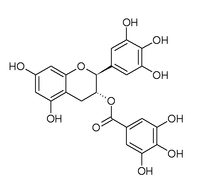- Gallocatechin gallate
-
Gallocatechin gallate Other names(-)-Gallocatechin gallate
(2S,3R)-2-(3,4,5-Trihydroxyphenyl)-3,4-dihydro-1(2H)-benzopyran-3,5,7-triol 3-(3,4,5-trihydroxybenzoate)Identifiers CAS number 4233-96-9 Jmol-3D images Image 1 - Oc1cc(cc(O)c1O)C(=O)O[C@@H]3Cc2c(cc(O)cc2O)O[C@H]3c4cc(O)c(O)c(O)c4
Properties Molecular formula C22H18O11 Molar mass 458.37 g mol−1 Exact mass 458.084911 u  gallate (verify) (what is:
gallate (verify) (what is:  /
/ ?)
?)
Except where noted otherwise, data are given for materials in their standard state (at 25 °C, 100 kPa)Infobox references Gallocatechin gallate (GCG) is the ester of gallocatechin and gallic acid and a type of catechin. It is an epimer of epigallocatechin gallate (EGCG).
In a high temperature environment, an epimerization change is likely to occur, because heating results in the conversion from EGCG to GCG.[1] According to the referenced study the resulting CGC (the epimer of EGCG) results in even lower dietary cholesterol absorption than occurs with EGCG. While this may be a beneficial outcome with respect to cholesterol reduction activity, for those wishing to maximize the EGCG content of green tea infusions, it is still appropriate to use high temperatures, as long as it is taking into account that extreme conditions will lead to small reductions in total EGCG, for example a 12.4% reduction in total EGCG when heated for 30 minutes straight at 100 degrees Celsius.[2]
References
- ^ Ikeda, Ikuo; Kobayashi, Makoto; Hamada, Tadateru; Tsuda, Koichi; Goto, Hitomi; Imaizumi, Katsumi; Nozawa, Ayumu; Sugimoto, Akio et al. (2003). "Heat-Epimerized Tea Catechins Rich in Gallocatechin Gallate and Catechin Gallate Are More Effective to Inhibit Cholesterol Absorption than Tea Catechins Rich in Epigallocatechin Gallate and Epicatechin Gallate". Journal of Agricultural and Food Chemistry 51 (25): 7303–7. doi:10.1021/jf034728l. PMID 14640575.
- ^ Wang, Rong; Zhou, Weibiao; Jiang, Xiaohui (2008). "Reaction Kinetics of Degradation and Epimerization of Epigallocatechin Gallate (EGCG) in Aqueous System over a Wide Temperature Range". Journal of Agricultural and Food Chemistry 56 (8): 2694–701. doi:10.1021/jf0730338. PMID 18361498.
Flavan-3-ols Afzelechin | Catechin (Epicatechin) | Epicatechin gallate | Epigallocatechin | Epigallocatechin gallate | Fisetinidol | Gallocatechin | Gallocatechin gallate | Guibourtinidol | Mesquitol | RobinetinidolO-methylated flavan-3ols Meciadanol (3-O-methylcatechin)Glycosides Arthromerin A | Arthromerin BMisc. This article about a natural phenol is a stub. You can help Wikipedia by expanding it.

